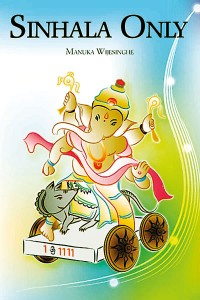A daring iconoclastic novel
View(s):Manuka Wijesinghe’s novels are entertaining as they address a variety of local social, cultural and political issues from an anti-establishment viewpoint. They are also imbued with a strong idiosyncratic flavour. This fearless writer uses her pen like a surgical knife to dissect Sri Lankan society. In her new satirical novel, “Sinhala Only”, she replaces the knife with a sword and wields it like a diabolical fencer. True, the pen is mightier than the sword (as we like to believe), but in Manuka’s hands, one is indistinguishable from the other as she sets about the business of destroying accepted beliefs, values and attitudes with manic intensity.
“Sinhala Only” is a no-holds-barred kind of literary exercise – a daring, iconoclastic, quintessentially Sri Lankan novel that attacks sacred cows with intellectual vigour and cerebral prose. A great deal of research has gone into this out-of-the-box novel with its weighty intellectual and speculative content. The incandescent prose bubbles from time to time like a piquant sauce on the boil. The writer is obsessed with the task of demystifying and reinterpreting Sri Lankan post-colonial history within an iconoclastic framework. As for sacred cows, here is one that is beheaded with a clean swipe of her lethal blade:
“SHRI was the epitome of Ceylonese ignorance without ethnic divide. All those pundits who had danced in the Peramuna did not seem to know that SHRI was not Sinhala. It was not even Tamil. SHRI had been introduced to the Tamil alphabet during the Pallava regency, since the Pallavas, though Dravidians, has used ‘Sanskrit’ in court protocol. For this purpose they had created an alphabet called Grantha, which was a mutation, NOT of Sanskrit’s Devanagari letters, but Dravidian Tamil letters. It was from Grantha that the Sinhala language derived, not just its SHRI, but its entire alphabet. The Pallava Grantha was a near imitation of Tamil, and Sinhala was a near imitation of Grantha.”
The insinuation (or should I say, speculation?) that the Sinhala language is rooted in a Dravidian template is likely to stir up a hornet’s nest of angry criticism and hostile protest. Will it result in intense debate and discussion? I think the author would be more than pleased if it did, given the provocative nature of her prose. Another sacred cow that is eviscerated is the doctrine of Sinhalese-Buddhist hegemony. There are many controversial statements in this tendentious novel and their potent additive effect may well trigger seizures in readers who regard themselves as diehard Sinhalese-Buddhist nationalists.
In this tripartite novel, each chapter is complete in itself and reflects some aspect of the overall theme (“Sinhala Only”). Every “episode” attempts to shed new light on the book’s unifying theme with the chapters collectively forming a mosaic. The blending of fierce polemics, learned speculations, and cerebral prose into an idiosyncratic mosaic is one of the fascinating aspects of the novel. Another is its heroic attempt at adding a global dimension to this mosaic, with its multiple interpretations, multiple voices, and multiple themes and motifs.
The novel spans 3-4 decades of Sri Lanka’s post-colonial history (late 1940s to the early 1970s) with emphasis on the 1950s. “Sinhala Only” does not have a plot, but it does have a sketchy storyline with a rich anecdotal flavour. It is centred on two families and their relatives and acquaintances. One family lives in Ruhuna, where the Sinhala Only slogan is becoming deeply entrenched, and the other, in Colombo, where S.W.R.D. is skating on thin ice. Implementation of the Sinhala Only Act (his brainchild) has tragic consequences, for it triggers widespread communal riots that leave the nation deeply divided. The author addresses these historical issues with a blend of eloquent prose and caustic wit.
The novel has heaps of interesting fictional characters (Sinhalese, Tamils, Muslims and Burghers), but no protagonist. The characters (especially the history teacher, Richard Fernando) drift in and out of the mosaic like phantoms and we lose track of their lives life from time to time. Mala, the vivacious and rebellious daughter of Ruhuna’s esteemed bridge builder, Hendrik de Silva, plays a fairly prominent role in the novel and could have been its focal point. This would have required the writer to convert the sketchy storyline into something more substantial with the protagonist linking the macrocosm (non-fiction) to the microcosm (fiction). After reading the book, one gets the impression the author has trouble deciding which is more important, the macrocosm or the microcosm, and how to connect the two. One also wonders if some of the author’s weighty speculations on global history and politics (macrocosm) are relevant to the novel. Perhaps it would have benefitted from some ruthless editing.
The macrocosm has a central motif (“Sinhala Only”), but not the microcosm. Hence, the reader cannot find a peg to hang his/her coat on. Perhaps the reason is the absence of a protagonist around whom a story usually revolves. No protagonist, no story. This is the conventional wisdom. But “Sinhala Only” is not a conventional novel. It is an experimental work that dispenses with conventional forms and structures. The writer should be commended for attempting something different. This is an ambitious novel despite its flaws.
All in all, an intriguing piece of work that is bound to provoke a belligerent response from the custodians of our so-called Sinhalese-Buddhist identity. This, perhaps, is the real purpose of “Sinhala Only”.
| Book facts
“Sinhala Only” by Manuka Wijesinghe. |


